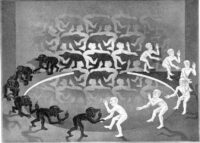I’m reading a 1996 book entitled “Demonic Males” which endeavors to explore the roots of male violence by examining the history and habits of our closest animal relative, the chimpanzee. Genome comparisons show we share 99 percent of our genes with chimpanzees, but genes tell only part of the story. Science has established that genes turn “on” or “off” (called “expression”) based on varying factors, and this forms the basis of the emerging science of epigenetics, the study of the factors that stimulate gene expression.
Until relatively recently, naturalists believed that chimpanzees lived in generally peaceful close-knit clans of relative harmony. Field research has proven otherwise, and the premeditated murderous behavior of male chimps directed at males from other “clans” is now well documented. Such behavior includes forming a pack that travels beyond the boundaries of its normal territory into the territory of another clan, hunting for a lone male member of that “foreign” clan and systematically attacking, maiming and often killing him. Repeated forays of this type often result in the elimination of all males within adjacent territories. In other words, like human beings, chimpanzees wage gang wars of aggression against their own kind. When chimpanzees and upright hominids split from a common ancestor, our male progenitors carried along some heavy baggage, and as of yet, human males have not unloaded it. Men still embody biological, genetic and epigenetic characteristics leading to widespread violence and aggression; this is a world-wide phenomenon. Although ancient and enduring teachings exist which explain the roots and mitigation of male aggression, and although laws and penalties associated with the commission of violence exist in every society, the carnage continues. Whether we may finally overcome millions of years of biologically hard-wired and learned violent behavior remains an open question.
Years ago I read “Last and First Men” by the author Olaf Stapledon, a British philosopher and writer. In it, Stapledon composes a narrative arc of 2 billion years, during which eighteen past and future civilizations of men rise and fall. Reaching exalted heights of intelligence and sophistication only to descend again into primitive savagery, the definition of “men” is variable; physically, technologically, culturally and in other visible and invisible ways, the men of these civilizations all struggle to overcome their own proclivity to violence. In the end, along with the planets of our solar system, the last men are consumed in the violent furnace of a supernova, not a terribly subtle message.
Because we can imagine a peaceful world reflecting our better nature the violent reality of our present situation is particularly challenging. People want security, contentment and a sense of purpose and there are some among us who find these. Unfortunately as nations and as individuals we continue to believe violence will stop violence, binding ourselves to a self-perpetuating cycle from which our species has found little escape. That we are bound to die is a fact, but that we are bound to violence is not. Unlike chimpanzees, human violence is subject to the choices we make, but we are confused about this.
It is widely taught people are inherently violent, sinful, have fallen from grace and are basically bad. Believing that, we then live up to this dominant narrative, generating a self-fulfilling prophecy of violence. Would things be different, I wonder, if we had widespread faith in being basically good?





Be First to Comment